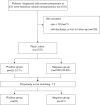Epidemiological and clinical characteristics of ammonia-producing microorganisms in the lungs of patients with severe pneumonia: a multicentre cohort study
- PMID: 39725980
- PMCID: PMC11673322
- DOI: 10.1186/s12967-024-05974-2
Epidemiological and clinical characteristics of ammonia-producing microorganisms in the lungs of patients with severe pneumonia: a multicentre cohort study
Abstract
Background: Ureaplasma urealyticum, Ureaplasma parvum, and Mycoplasma hominis were widely known as ammonia-producing microorganisms and can cause hyperammonemia, leading to cerebral edema and altered consciousness, which represent serious complications in lung transplant recipients. However, there is limited knowledge on the epidemiology and outcomes of infections caused by U. urealyticum, U. parvum, and M. hominis in non-transplant patients with severe pneumonia in the ICU.
Methods: Patients with severe pneumonia who underwent clinical metagenomics of bronchoalveolar lavage fluid (BALF) at the intensive care units (ICUs) of 17 medical centers from January 2019 to March 2023 were enrolled. All cases were divided into the positive group and the negative group based on whether U. urealyticum, U. parvum, or M. hominis was detected in lower respiratory tract. The clinical characteristics and outcomes were compared among the groups. The survival analysis after propensity score matching (PSM) was used to evaluate whether the mortality rate of U. urealyticum, U. parvum, and M. hominis positive patients were increased. Multivariate logistic regression was used to evaluate whether these microbials positivity were a risk factor for central nervous system dysfunction.
Results: In a total number of 1737 patients, 55 patients (3.17%) in the positive group and 1682 patients (96.83%) in the negative group. Patients in the positive group were younger, had a greater proportion of male patients, and had a longer time from ICU admission to clinical metagenomics testing. In contrast, the negative group had a higher proportion of patients with cerebrovascular disease. After PSM, there was no statistically significant difference in 28-day mortality following ICU admission between the two groups (hazard ratio [HR], 0.842; 95% confidence interval [CI], 0.489-1.451; p = 0.536). Multivariate logistic regression analysis showed an association between the detection of U. urealyticum, U. parvum, or M. hominis and neurological dysfunction (odds ratio [OR], 1.84; 95% CI 1.04-3.24; p = 0.035).
Conclusion: The detection of U. urealyticum, U. parvum, or M. hominis in the lungs of patients is associated with neurological dysfunction.
Keywords: Mycoplasma hominis; Ureaplasma parvum; Ureaplasma urealyticum; Hyperammonemia; Neurological dysfunction; Severe pneumonia.
© 2024. The Author(s).
Conflict of interest statement
Declarations. Ethics approval and consent to participate: The study has been approved by the ethics committees of the first affiliated hospital, Zhejiang university school of medicine and other participating hospitals. As a retrospective study, informed consent was waived. Consent for publication: Not applicable. Competing interests: The authors declare that they have no competing interests.
Figures



Similar articles
-
Prevalence of cervical colonization by Ureaplasma parvum, Ureaplasma urealyticum, Mycoplasma hominis and Mycoplasma genitalium in childbearing age women by a commercially available multiplex real-time PCR: An Italian observational multicentre study.J Microbiol Immunol Infect. 2018 Apr;51(2):220-225. doi: 10.1016/j.jmii.2017.05.004. Epub 2017 Jun 28. J Microbiol Immunol Infect. 2018. PMID: 28711440
-
Prevalence of Mycoplasma hominis, Ureaplasma urealyticum, and Ureaplasma parvum detection in urine and respiratory tract samples in Hiroshima, Japan.Heliyon. 2023 Mar 11;9(3):e14543. doi: 10.1016/j.heliyon.2023.e14543. eCollection 2023 Mar. Heliyon. 2023. PMID: 36967949 Free PMC article.
-
Detection of Mycoplasma genitalium, Mycoplasma hominis, Ureaplasma parvum (biovar 1) and Ureaplasma urealyticum (biovar 2) in patients with non-gonococcal urethritis using polymerase chain reaction-microtiter plate hybridization.Int J Urol. 2004 Sep;11(9):750-4. doi: 10.1111/j.1442-2042.2004.00887.x. Int J Urol. 2004. PMID: 15379939
-
Should we be testing for urogenital Mycoplasma hominis, Ureaplasma parvum and Ureaplasma urealyticum in men and women? - a position statement from the European STI Guidelines Editorial Board.J Eur Acad Dermatol Venereol. 2018 Nov;32(11):1845-1851. doi: 10.1111/jdv.15146. Epub 2018 Jul 6. J Eur Acad Dermatol Venereol. 2018. PMID: 29924422 Review.
-
Mycoplasma hominis, Ureaplasma parvum, and Ureaplasma urealyticum: hidden pathogens in peritoneal dialysis-associated peritonitis.Int J Infect Dis. 2023 Jun;131:13-15. doi: 10.1016/j.ijid.2023.03.032. Epub 2023 Mar 21. Int J Infect Dis. 2023. PMID: 36948449 Review.
Cited by
-
Co-detection of respiratory pathogens in children with Mycoplasma pneumoniae pneumonia: a multicenter study.Front Pediatr. 2025 May 23;13:1482880. doi: 10.3389/fped.2025.1482880. eCollection 2025. Front Pediatr. 2025. PMID: 40487016 Free PMC article.
-
The Landscape of lower respiratory tract herpesviruses in severe pneumonia patients: a multicenter, retrospective study with prospective validation.Crit Care. 2025 Jun 20;29(1):254. doi: 10.1186/s13054-025-05496-3. Crit Care. 2025. PMID: 40542368 Free PMC article.
References
-
- Sakusic A, Rabinstein AA. Acute coma. Neurol Clin. 2021;39:257–72. - PubMed
-
- Edlow JA, Rabinstein A, Traub SJ, Wijdicks EFM. Diagnosis of reversible causes of coma. Lancet. 2014;384:2064–76. - PubMed
-
- Watson AJ, Chambers T, Karp JE, Risch VR, Walker WG, Brusilow SW. Transient idiopathic hyperammonaemia in adults. Lancet. 1985;2:1271–4. - PubMed
-
- Buzo BF, Preiksaitis JK, Halloran K, Nagendran J, Townsend DR, Zelyas N, et al. Association between mycoplasma and ureaplasma airway positivity, ammonia levels, and outcomes post-lung transplantation: a prospective surveillance study. Am J Transpl. 2021;21:2123–31. - PubMed
-
- Wylam ME, Kennedy CC, Hernandez NM, Peters SG, Maleszewski JJ, Cassivi SD, et al. Fatal hyperammonaemia caused by mycoplasma hominis. Lancet. 2013;382:1956. - PubMed
Publication types
MeSH terms
Substances
Grants and funding
LinkOut - more resources
Full Text Sources
Medical
Miscellaneous

